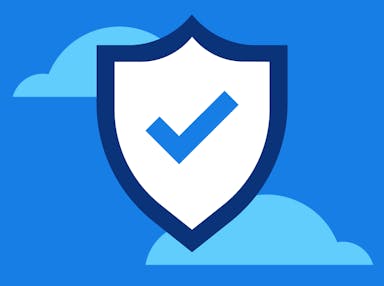
Compliance as a Service: The Path to Scalable Growth for IT Service Providers
Emily Bonnie
Senior Content Marketing Manager
Aaron Melear
VP of Partnerships and Alliances
For growth-minded Managed Service Providers and Managed Security Service Providers, scaling revenue while maintaining margins and retaining customers is no small feat. The market is increasingly competitive, with commoditization driving down prices and evolving client demands reshaping expectations. Despite these challenges, most service providers maintain ambitious growth targets — 70% of providers are aiming for double-digit annual revenue growth.
To achieve these goals, MSPs and MSSPs need to move beyond traditional services and explore new, scalable opportunities. Compliance as a Service (CaaS) has emerged as a game-changer, enabling service providers to not only differentiate their offerings but also build recurring revenue streams and deepen customer relationships. In this article, we’ll explore how MSPs and MSSPs can leverage CaaS as a powerful growth engine for their business.
What is Compliance as a Service (CaaS)?
Compliance can often feel overwhelming for companies when they’re first getting started. Understanding which specific regulations and frameworks they need to comply with, navigating control requirements and documentation, and managing the manual workload of completing an audit are all complex and resource-intensive tasks. And as these businesses scale, they start to understand that security and compliance are not one-off IT projects but rather ongoing business processes that need to be maintained and optimized over time — processes that often require significant investment and special expertise.
Compliance as a Service allows these companies to outsource their compliance needs to experts. They can access the detailed knowledge of compliance service providers to help navigate the cybersecurity and compliance landscape, getting specific advice and best practices tailored to their business needs to streamline the entire process.

For MSPs and MSSPs, offering managed compliance services means providing clients with:
- Compliance implementation: Developing policies, procedures, and controls tailored to specific frameworks that satisfy the client’s regulatory and industry requirements.
- Ongoing monitoring: Continuously assessing the client’s compliance posture, vulnerabilities, and risks.
- Audit readiness: Simplifying preparation for audits with automated evidence collection and compliance reporting.
Compliance has become a business imperative, yet many companies are navigating a complex industry and regulatory landscape without the in-house expertise or resources needed to manage compliance effectively. As compliance standards become a higher priority, MSSPs have a unique opportunity to fill this gap while creating a scalable, high-margin service offering.
Let’s examine a few ways MSPs and MSSPs can benefit from integrating CaaS into their business model.
Increase recurring revenue
Compliance services provide a natural pathway for steady, predictable revenue streams. Unlike one-off security implementations or incident response engagements, compliance is an ongoing process that requires continuous monitoring, regular updates, and periodic audits.
By offering a CaaS model, MSPs and MSSPs can transform a traditionally project-based revenue stream into one centered on long-term contracts and recurring income. As clients recognize the value of staying compliant year-round — especially in highly regulated industries like finance and healthcare — they're more likely to commit to ongoing support. This approach not only increases financial stability for providers but also allows for better forecasting and strategic planning.
Improve client retention
Building compliance into your service offerings deepens your relationship with clients, shifting your role from a transactional vendor to a trusted strategic partner. By helping clients navigate the complexities of compliance, you position yourself as an indispensable part of their operational strategy.
This deeper partnership builds trust and loyalty, making it significantly harder for clients to consider switching providers. Plus, the longer you manage a client’s compliance, the more embedded your processes and tools become, further solidifying the relationship and reducing churn.
Differentiate in a crowded market
In a crowded market where MSPs and MSSPs often compete on price, offering CaaS provides a powerful way to stand out. As compliance becomes a critical priority for all kinds of businesses, many organizations are actively seeking providers that can help them built both a strong security posture that protects against data breaches and a solid foundation for continuous compliance.
By integrating CaaS into your services, you differentiate yourself as a provider that can not only secure your clients’ systems against threats but also ensures ongoing regulatory compliance. This added layer of expertise makes your offerings more appealing to prospects who need both security and compliance support, giving you a competitive edge and opening doors to industries that might have otherwise been out of reach.
Example: SOC 2 as a Service
SaaS startup TechSync is growing rapidly and ready to scale into enterprise markets. But they hit a roadblock: enterprise prospects demand assurance that TechSync can protect their sensitive data and are compliant with industry standards, specifically SOC 2. TechSync knows they need a SOC 2 report to clear the due diligence process and close upmarket deals, but they lack the in-house expertise, tools, and bandwidth to navigate the complex SOC 2 compliance process.
Enter the MSSP, SecureShield, which offers SOC 2 as a Service as part of its CaaS model. SecureShield partners with TechSync to manage the entire SOC 2 journey, including an initial gap assessment, control implementation, policy creation and document management, evidence collection, and audit readiness assessment.
When TechSync is fully prepared for their SOC 2 audit, SecureShield takes the lead in fielding questions and additional evidence requests from the audit firm, ensuring all documentation is presented clearly and TechSync receives a clean audit report.
After achieving SOC 2 certification, SecureShield continues to monitor TechSync’s compliance status. Through continuous monitoring and automated alerts, SecureShield ensures that TechSync maintains compliance and avoids any surprises during their annual SOC 2 audit.
The partnership is a win-win for SecureShield and TechSync. SecureShield generates a high-margin, recurring revenue stream while reinforcing their position as a trusted compliance partner. And by outsourcing SOC 2 compliance to SecureShield, TechSync achieves certification faster and more efficiently than if they had managed the process internally. The automation and ongoing monitoring provided by SecureShield ensure that compliance becomes a seamless part of TechSync’s operations, rather than a resource-intensive distraction. With their SOC 2 report in hand, TechSync can earn the trust of larger enterprise clients and unlocks significant new revenue opportunities.
Recommended Reading

Top 5 Ways to Increase MSP Business Revenue
Industries that benefit from CaaS solutions
Any business looking to outsource complex compliance processes and streamline operations can consider the CaaS model. However, certain industries face additional regulatory requirements and challenges that make them ideal candidates for CaaS:
- Healthcare: Help healthcare organizations navigate HIPAA, HITRUST, and other applicable frameworks by offering automated risk assessment workflows, incident response planning, vendor risk management, scope definition, and ongoing monitoring for electronic Protected Health Information (ePHI).
- Financial services: Help companies streamline compliance with standards like PCI DSS and SOX with cardholder data security, policy development, vulnerability scanning, and compliance monitoring.
- SaaS businesses: Cloud service companies typically need to comply with industry standards like SOC 2, ISO 27001, and NIST CSF to remain competitive, as well as GDPR, CCPA, and other data privacy laws. Service providers can help these businesses understand framework requirements, cross map controls to reduce duplicate work, conduct required security training, and guide audit prep for efficient and successful security assessments.
- Government contractors and subcontractors: Automate compliance processes for industries like energy, utilities, and environmental services, as well as private companies offering their services to government agencies. CaaS can help ensure compliance with stringent federal frameworks like NIST 800-53, FedRAMP, and CMMC 2.0 so these clients can focus on critical business operations.
How to work with clients under the CaaS model
Offering CaaS successfully requires a structured, collaborative approach that helps clients build strong compliance programs while supporting their operational needs. Below is a detailed breakdown of the process, along with best practices MSSPs should adopt to deliver exceptional service and foster long-term client relationships.
1. Assess the client’s compliance requirements
The first step in any CaaS initiative is to assess the client’s unique compliance landscape and needs. This involves understanding the regulatory requirements relevant to their industry, evaluating their current business processes, and identifying potential gaps or vulnerabilities in their compliance posture. Develop a risk profile to capture key areas of concern, including high-priority threats and customer/stakeholder expectations.
This stage often involves conducting initial interviews, reviewing documentation, and analyzing the client’s existing controls to determine their current level of compliance with applicable frameworks or standards. The goal is to create a clear picture of where the client stands and what steps will be required to bring them into full compliance.
2. Recommend appropriate compliance frameworks
Once the assessment is complete, the next step is to identify and propose the most relevant compliance frameworks. This process involves outlining the specific regulatory standards the client must comply with and mapping out the policies, procedures, and controls necessary to achieve compliance.
For example, a SaaS business might need to adhere to SOC 2 standards, which would require implementing robust access controls, developing an incident response plan, and ensuring consistent logging and monitoring of system activity.
At this stage, it’s important to package your CaaS offerings in a way that clearly addresses the client’s needs. This could include:
- Performing detailed risk assessments to identify and address compliance risks.
- Working with the client to define which systems, processes, and data sources are in scope for a compliance audit.
- Conducting a gap analysis to pinpoint any discrepancies between the client’s current security posture and framework requirements.
- Assisting with remediation by implementing controls, policies, and processes tailored to the relevant frameworks.
- Providing continuous monitoring and proactive remediation of any vulnerabilities or compliance issues.
The key is to offer a comprehensive service that simplifies compliance management for the client while showcasing the overall value of partnering with your MSSP.
3. Connect integrations to data sources
Before implementing any compliance measures, it’s essential to integrate a compliance management system with the client’s systems and data sources. Deep integrations allow for accurate security and compliance monitoring, allowing MSPs to get full visibility and actionable insights into existing controls, how those controls map to framework requirements, and automatically collect evidence for external audits.
These integrations can also automatically identify any compliance gaps that need to be addressed. Using this information, a detailed remediation plan can be developed, including timelines, responsible parties, and specific actions required to close gaps.
4. CaaS vendor closes compliance gaps
Once integrations are in place and gaps have been identified, the CaaS provider works to implement the necessary controls, policies, and procedures to achieve compliance. This often includes:
- Creating or updating existing policies, processes, and technical controls to align with the selected framework requirements
- Conducting security awareness training
- Implementing compliance solutions to automate control monitoring and evidence collection
- Setting up compliance dashboards for real-time visibility into progress and easy reporting
- Establishing service-level agreements (SLAs) to maintain accountability
This phase is critical, as it lays the groundwork for achieving compliance and maintaining it over time. Work closely with the client’s internal teams to ensure a smooth implementation and remediation process and establish a strong partnership.
4. CaaS vendor monitors and maintains compliance
Compliance tasks don’t end once the audit is complete. Ongoing compliance monitoring and maintenance are essential to ensure the client remains compliant as regulations change and their business grows.
Your MSSP should proactively track the client’s compliance posture using automated tools that provide real-time performance metrics and regular reports. These insights allow your MSSP to identify potential issues early and address them for the client before they escalate. This continuous improvement not only helps your client stay compliant but also reinforces the value of your ongoing partnership.
Recommended Reading

10 Common Cybersecurity Frameworks: Choosing the Right One for Your Clients
Is implementing CaaS the right choice for your MSSP?
With businesses under growing pressure to meet complex regulatory requirements, offering CaaS can be a natural extension of your MSSP’s expertise. But is it the right move for your business? Let’s explore the key factors and challenges MSSPs should consider when deciding whether to add CaaS to their portfolio.
Resource requirements
Compliance requires specialized knowledge and tools. If your team lacks the necessary compliance experts, you may need to invest in training or hire dedicated compliance professionals. Plus, implementing CaaS can demand significant time and resources, particularly in the initial setup phase.
While CaaS can significantly boost ARR by generating consistent income from long-term contracts, you’ll need to determine how CaaS revenue compares to your existing services and whether long-term ROI offsets the initial investment.
Profitability and scalability
While compliance services can have high margins, consider factors like staffing, tools, and operational costs to assess the profitability of your CaaS offerings and ensure they contribute positively to your bottom line.
To scale efficiently and lower operational costs, MSSPs should partner with compliance automation platforms that streamline evidence collection, continuously monitor controls, automate risk assessments and remediation, and simplify reporting. These tools not only reduce the time and resources needed for manual compliance management but also enable MSSPs to serve more clients simultaneously, improving profitability and scalability by creating a more efficient, repeatable service model.
Data security risks
Handling sensitive client data as part of compliance services introduces potential security and liability risks, including potential exposure to data breaches, regulatory fines, and legal liabilities. Limiting access to and handling of this information is crucial to protecting both your clients and your MSSP’s reputation.
To reduce exposure, adopt a "least privilege" approach, ensuring that only authorized personnel have access to sensitive data, and only to the extent required for their role. Use secure, encrypted communication channels for data transfers, and rely on automated compliance tools that minimize manual data handling. These tools not only reduce human error but also limit the amount of sensitive information directly accessible to your team.
Client satisfaction
Solicit direct feedback from clients who use your CaaS offerings. This can provide valuable insights into what’s working, what isn’t, and how you can improve your services. Send surveys or hold regular check-ins where clients can share their thoughts on your services, responsiveness, and overall impact on their compliance goals. This anecdotal feedback can help you fine-tune your services and address any client pain points proactively.
High satisfaction rates and Net Promoter Scores can also indicate whether your services are aligning with client expectations, and higher client retention rates signal that your CaaS offerings are impacting loyalty. By leveraging both direct feedback and client satisfaction metrics, you can continuously refine your CaaS offerings and ensure they remain a valued asset for your clients.
Recommended reading

The Future of Compliance Automation: Trends and Predictions for 2025
Offer differentiated cybersecurity and compliance services with Secureframe
As businesses face increasing regulatory demands, many are turning to outsourced compliance as an efficient, cost-effective solution for maintaining continuous compliance and strengthening their security posture. For MSPs and MSSPs, adopting an automated security and compliance platform can revolutionize how you serve your clients. By automating routine manual tasks like evidence collection, control monitoring, and reporting, you can enhance both the efficiency and effectiveness of your managed compliance services, driving client satisfaction and recurring revenue.
Secureframe’s Service Partner Program makes it simple for IT and security providers to integrate compliance solutions into their offerings, delivering exceptional value to clients while streamlining your operations. The program offers:
- A free gap assessment tool to kickstart compliance efforts for your clients.
- A flexible, monthly pay-as-you-go billing model that aligns with your business needs.
- No minimum commitment, so you can scale at your own pace.
- Low-cost foundational security frameworks, exclusive to service providers, to expand your service portfolio.
Learn more about our partner program today.
Join our Service Partner Program
FAQs
What are the three types of compliance?
The three types of compliance are regulatory compliance, which involves adhering to laws and regulations; industry compliance, which focuses on meeting standards set by industry organizations (e.g., PCI DSS or SOC 2); and internal compliance, which ensures adherence to a company’s own policies and procedures.
What is compliance as a service in cloud computing?
Compliance as a Service (CaaS) in cloud computing is a managed service that helps organizations ensure their cloud environments comply with regulatory requirements and industry standards. It typically includes automated monitoring, policy enforcement, and real-time reporting for frameworks like GDPR, HIPAA, or ISO 27001.
What are the 5 keys of compliance?
The 5 keys of compliance are:
- Understanding requirements: Identifying applicable laws, regulations, and standards.
- Policy development: Creating clear, enforceable policies to meet compliance needs.
- Control implementation: Deploying technical and procedural safeguards.
- Employee training: Ensuring staff understands their roles in maintaining compliance.
- Auditing and monitoring: Assessing and continuously tracking compliance.
What is the compliance as a service (CaaS) model?
The CaaS model involves businesses outsourcing compliance management to experts who provide services like regulatory guidance, framework implementation, monitoring, and reporting. It’s a recurring, managed service that simplifies compliance for clients while offering MSSPs a high-margin, scalable revenue stream.
What is identity and compliance as a service?
What is identity and compliance as a service?
Identity and Compliance as a Service combines identity management with compliance solutions to ensure that user access aligns with regulatory and organizational policies. It helps organizations protect sensitive data while meeting compliance standards for access and identity verification.

Emily Bonnie
Senior Content Marketing Manager
Emily Bonnie is a seasoned digital marketing strategist with over ten years of experience creating content that attracts, engages, and converts for leading SaaS companies. At Secureframe, she helps demystify complex governance, risk, and compliance (GRC) topics, turning technical frameworks and regulations into accessible, actionable guidance. Her work aims to empower organizations of all sizes to strengthen their security posture, streamline compliance, and build lasting trust with customers.

Aaron Melear
VP of Partnerships and Alliances
Aaron Melear served as Vice President of Partnerships and Alliances at Secureframe, where he built and scaled the company’s global partner ecosystem. With over a decade of experience leading channel and alliance programs at top cybersecurity organizations—including Duo Security and Vanta—Aaron is passionate about helping partners accelerate revenue growth through automation, collaboration, and trust. During his tenure, he focused on empowering MSPs, auditors, and consulting partners to deliver faster, smarter compliance outcomes for their clients using Secureframe’s platform.